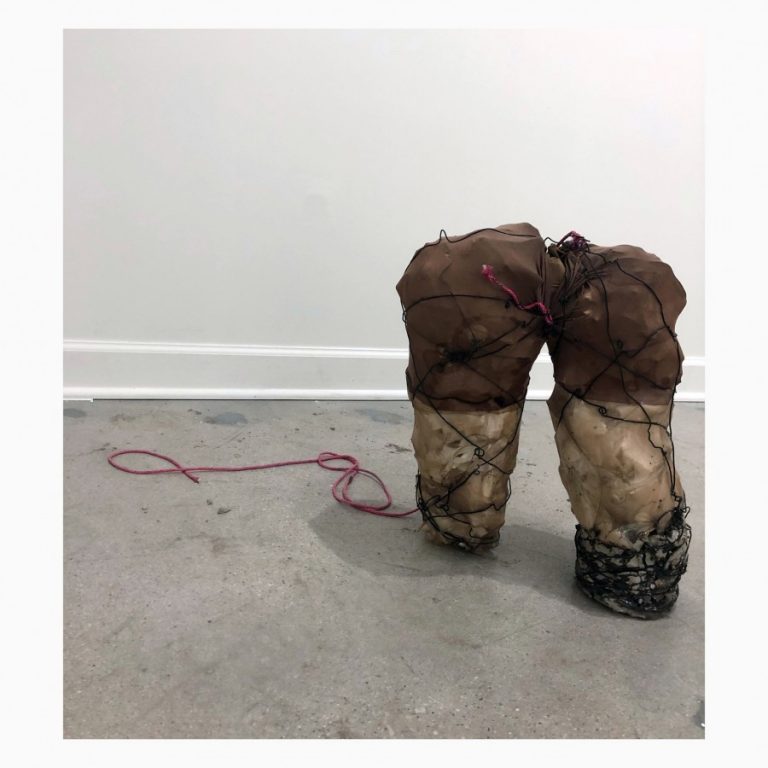Julia Klein: And then: Closing Reception
@ Material
2025 W Belmont Ave., Chicago, IL 60618
Opening Sunday, November 3rd, from 3PM - 5PM
On view through Sunday, November 3rd
Please join us at Material for the Closing Reception of And then, curated by Teresa Silva
November 3rd, 3 pm – 5pm
A conversation between Julia Klein and curator Teresa Silva will begin at 4pm
Julia Klein: And then
In modern and contemporary art, combining discarded materials is not a new approach. In the early twentieth century, Marcel Duchamp made a hybrid sculpture by fastening a bicycle wheel atop a wooden stool, and he made more versions of said sculpture into the mid-twentieth century. In the 1950s and beyond, Robert Rauschenberg made what he dubbed combines whereby pairing unconventional materials with de-skilled artistry. While Duchamp and Rauschenberg’s sculptures were decidedly non-narrative, they did provide commentary on the world around them. Duchamp’s amalgamation of everyday objects was a comment on crass capitalism and the speedy rise of mass production. Rauschenberg’s combines pointed to man-made environmental catastrophes that have led to global water and air pollution. The artists’ assemblages were meant to arrest one’s attention and generate critical awareness of our complicity. One cannot help but think about these issues now and that decades on it’s all the more dreary — but also rife with radical imagination and hope in human ingenuity to bring about change.
In the year 2000, I was in Berlin and came to see assemblage art in a new way. I visited the now-defunct Tacheles building, occupied by artists as live-work spaces, and wandered about curious to find something. The building was a derelict pre-World War II altbau, in the former East where resources were scarce and the euphoria of reunification in 1990 was long left behind. Capitalism wasn’t working so well for East Berlin. The job outlook was dismal and rampant gentrification was taking hold. What was left of altbau and plattenbau housing were being demolished or left in shambles.
Inside one studio, I noticed a sprawling floor sculpture, resembling at once a cityscape and reclining body. The artist was present and we talked about his use of materials and what his process was like. He said he collected objects found in the building’s stairwells and outdoor grounds. The sculpture felt like alchemy, recasting detritus as limitless creative fodder. Witnessing in-person his artistic process in flux, and the jarring combinations of dead pc monitors, crumbling architectural fixtures, and leftover food packaging, re-ordered my thinking about assemblage.
And then marks a new moment in Julia Klein’s ongoing engagement with discarded materials and her ever evolving process and intentions of re-working and re-presenting objects in different contexts and space. And then as language may connote to concatenate things, so they add up (think of the statement: one plus one equals two). But, Klein’s artistic process is not linear. The origins and initial purposes of found materials – how they were used, thought about, felt, and deployed in relation to other objects – motivate Klein’s impulse to scramble them with both spontaneity and formal intellect for the present moment and possible future reuse. Using a deft artistic hand, she shifts materials and their meaning over, and over, and over again.
Works on view in this exhibition gather remnants of accrued and saved materials, over many years and demonstrate a more recent experimentation with weight and suspension and considering the body in space. Moves like hanging, chopping, grounding, standing, leaning, and daubing color are made by the artist to mess with our perception of the body, both its interiority and exteriority. Klein employs rope, clay, wire, pantyhose, paper, plaster, resin, hooks and weights to generate an unstable formal and emotive context for this body of work. More than material, Klein’s emphasis on chance champions the value of process, insofar as keeping the work alive, spirited, and dynamically fragmented.
-Teresa Silva
*With admiration and gratitude to Julia Klein and Jean Alexander Frater.
Official Website
More events on this date
Tags: And then, Chicago, Julia Klein, Material, North Center

« previous event
next event »